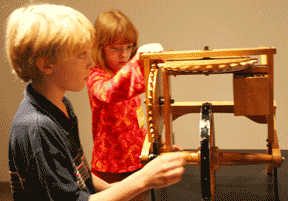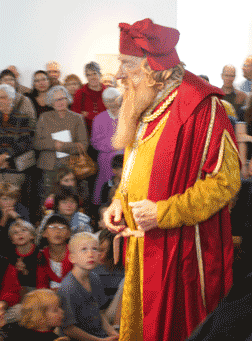 |
|||||||||||
|
|||||||||||
|
|||||||||||
There’s More to Leonardo da Vinci
|
|||||||||||
 |
photos by Cathy Conway Miller |
 |
Do you like to tinker with motorcycles? Are you curious about how things work? Do you spend time watching birds? Do you say, I could come up with a better way of doing this? Do your kids like to make things move and figure them out?
Perhaps you and your kids are like the Italian artist Leonardo da Vinci. Leonardo is most famous for his paintings, Mona Lisa and The Last Supper, but he used his curiosity and powers of observation in his inventions as well as his art.
A new exhibit at St. John’s College in Annapolis shows how one of history’s most respected artists invented some marvelous machines centuries ahead of their time. These almost modern-looking machines include a parachute, a spring-driven car, a variable-speed drive, a printing press, a paddle-wheel ship and a tank equipped with cannons.
It is a great exhibit for people who are interested in things with moving parts. The curators encourage you to operate these machines. Since the museum usually displays works of art, “it is nice to have an exhibit you can touch,” says art educator Lucinda Edinberg.
Technicians at IBM built these 16 models in the 1950s. They found Leonardo’s sketches so accurate in proportion that they had no problems building the models from his drawings.
Leonardo Speaks
Leonardo arrived in the person of Dr. Ted Brown of Severna Park for the official opening of the exhibit.
Speaking to the gallery’s junior members and a crowd of adults, Leonardo advised the enthralled young people to “keep a messy room, collect things, keep trying new things and don’t give up real quick.”
Three out of four of his inventions were never made, he said, but he never gave up exploring and inventing.
Leonardo never went to school and had little formal education. His uncle Francesco taught him how to wonder about things and inspired his love of the natural world. All his life, he learned from nature. His hours of watching birds in flight gave him ideas for his flying machine.
“Answer every question with two more,” Leonardo advised.
The Range of Genius
In Leonardo’s time, people thought that each machine was different because it did a different job. He realized that the same mechanism in one machine — a gear, pulley or spring — could be used in a second machine for another function altogether. By combining these mechanisms in new ways, Leonardo envisioned new machines for new purposes.
Leonardo — who died in 1519 at age 67 — was exactly what he seems: a gifted genius good at many things. He wrote with both hands and was an extraordinary athlete with exceptional coordination. He was a sculptor as well as a painter. He designed military fortifications at a time of frequent warfare. And, Brown claims, he had the “best singing voice in Italy.” People would stop him on the street to ask him to sing. He played the flute and lyre and wrote music.
Would Leonardo’s inventions have worked if they had been built during his lifetime? Some would have. He invented the lock system for canals and designed a flood control system still operating in Florence, Italy.
Others, like his submarine, would not have worked. A wooden submarine would leak, and his metal submarine could not have been built “until the Industrial Revolution and the invention of metallurgy,” according to naval architect Bruce Johnson, professor emeritus at the United States Naval Academy.
Leonardo’s sketches, upon which these models are based, are blown up and line the walls of the exhibit. He recorded his ideas, observations and sketches in thousands of notebook pages. Many of the pages are lost, but thousands remain. The most important, called the Codex Leicester, is owned by Bill Gates, who bought it for $30.8 million.
The Inventions of Leonardo da Vinci, with models donated by the IBM Corporation, is circulated by The Exhibition Alliance.
See this exhibit if you’re interested in mechanics and how things work, or if you want to understand the mind of an artist whose curiosity stretched far beyond his art. I expect you, like the adults and young people at the opening on Sunday, will be amazed and intrigued.
On exhibit thru Dec. 15 at noon to 5pm Tues. to Saturday plus 7-8pm Fri. @ the Mitchell Gallery, St. John’s College, Annapolis. Free: 410-626-2556, www.stjohnscollege.edu
Tours are led by docents between noon and 3pm each Thur. Art educator Lucinda Edinberg leads tours Nov. 14 (12:15-12:45pm) and Dec. 9 (3pm).
|
Current Issue \\ Archives \\ Subscriptions \\ Clasified Advertising \\ Display Advertising |
© COPYRIGHT 2007 by New Bay Enterprises, Inc. All rights reserved.
